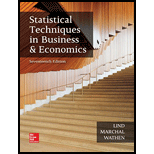
Concept explainers
(a)
Find the maximum numbers of employees per store.
Find the minimum numbers of employees per store.
(a)
Answer to Problem 1.1SR
The maximum numbers of employees per store is 105 employees.
The minimum numbers of employees per store is 79 employees.
Explanation of Solution
In the dotplot of number of employees for each of 142 Home Depot stores, the horizontal line represents ‘Number of employees’.
From dotplot, it can be observed that, the maximum or largest number of employees for one of the store is 105 employees. Also, the minimum or smallest number of employees for one of the store is 79 employees.
Hence, the maximum numbers of employees per store is 105 employees and the minimum numbers of employees per store is 79 employees.
(b)
Find the number of stores that employ 91 people.
(b)
Answer to Problem 1.1SR
The number of stores that employ 91 people is 15 stores.
Explanation of Solution
In the dotplot of number of employees, count the number of dots corresponding to 91 employees on the horizontal line. The number of dots corresponding to 91 employees is 15.
Hence, the number of stores that employ 91 people is 15 stores.
(c)
Identify around what values the number of employees per store tends to cluster.
(c)
Answer to Problem 1.1SR
The values around which the number of employees per store tends to cluster are 88 employees to 97 employees.
Explanation of Solution
From dotplot, it can be observed that, most of the stores have about 88 to 97 employees. The ‘number of employees for each store’ is clustered around the values 88 to 97, because approximately 75% of the stores are covered under this
Hence, the values around which the number of employees per store tends to cluster are 88 employees to 97 employees.
Want to see more full solutions like this?
Chapter 4 Solutions
Loose Leaf for Statistical Techniques in Business and Economics
- A company found that the daily sales revenue of its flagship product follows a normal distribution with a mean of $4500 and a standard deviation of $450. The company defines a "high-sales day" that is, any day with sales exceeding $4800. please provide a step by step on how to get the answers in excel Q: What percentage of days can the company expect to have "high-sales days" or sales greater than $4800? Q: What is the sales revenue threshold for the bottom 10% of days? (please note that 10% refers to the probability/area under bell curve towards the lower tail of bell curve) Provide answers in the yellow cellsarrow_forwardFind the critical value for a left-tailed test using the F distribution with a 0.025, degrees of freedom in the numerator=12, and degrees of freedom in the denominator = 50. A portion of the table of critical values of the F-distribution is provided. Click the icon to view the partial table of critical values of the F-distribution. What is the critical value? (Round to two decimal places as needed.)arrow_forwardA retail store manager claims that the average daily sales of the store are $1,500. You aim to test whether the actual average daily sales differ significantly from this claimed value. You can provide your answer by inserting a text box and the answer must include: Null hypothesis, Alternative hypothesis, Show answer (output table/summary table), and Conclusion based on the P value. Showing the calculation is a must. If calculation is missing,so please provide a step by step on the answers Numerical answers in the yellow cellsarrow_forward
 Glencoe Algebra 1, Student Edition, 9780079039897...AlgebraISBN:9780079039897Author:CarterPublisher:McGraw Hill
Glencoe Algebra 1, Student Edition, 9780079039897...AlgebraISBN:9780079039897Author:CarterPublisher:McGraw Hill Holt Mcdougal Larson Pre-algebra: Student Edition...AlgebraISBN:9780547587776Author:HOLT MCDOUGALPublisher:HOLT MCDOUGAL
Holt Mcdougal Larson Pre-algebra: Student Edition...AlgebraISBN:9780547587776Author:HOLT MCDOUGALPublisher:HOLT MCDOUGAL Functions and Change: A Modeling Approach to Coll...AlgebraISBN:9781337111348Author:Bruce Crauder, Benny Evans, Alan NoellPublisher:Cengage Learning
Functions and Change: A Modeling Approach to Coll...AlgebraISBN:9781337111348Author:Bruce Crauder, Benny Evans, Alan NoellPublisher:Cengage Learning Algebra: Structure And Method, Book 1AlgebraISBN:9780395977224Author:Richard G. Brown, Mary P. Dolciani, Robert H. Sorgenfrey, William L. ColePublisher:McDougal Littell
Algebra: Structure And Method, Book 1AlgebraISBN:9780395977224Author:Richard G. Brown, Mary P. Dolciani, Robert H. Sorgenfrey, William L. ColePublisher:McDougal Littell



